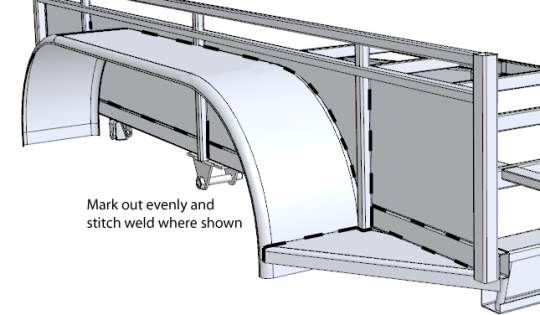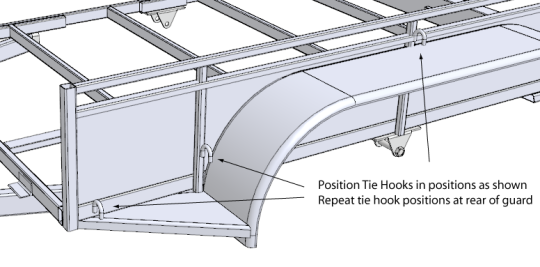
GUARDS

To find the correct position of the mudguard, fit the axle to the springs loosely, dry assemble the bearings and hubs and fit the wheels to the hubs.
Place an offcut of timber or steel around 40-50mm thick on top of the tyre and lower the guard onto this. Stand back and check the clearance around the front and rear. The guard can be pulled open if needed to allow for a better fit. Whatever measurement you pulled the guard out to, make sure that the other guard matches.
The guard needs to have roughly equal clearance at the front, top and rear, but pays to give a little extra at the top to compensate for spring movement.
Once the guard is in the correct position, tack weld the guard in position (another set of hands is recommended), and then stand back and check the guard and how it looks.
If the guard doesn't look quite right, now is the time to adjust it.
When happy with the guard position, mark out the position of the central upright and break the tack welds.
Using a grinder with a cutting blade, notch out the guard to fit the centre uprights.
GUARD GUSSETS
Guard gussets provide a couple of necessary functions, firstly to give the guard strength and support especially as the guards are normally the first things to get knocked around. Secondly they function as a step onto and into the trailer. Be wary of using a piece of rod or pipe to brace the guard, slip on this, when you are climbing into the trailer, you are likely to break your leg if you fall between the brace and the trailer.

When fabricating the gussets, ensure you make 2 pieces as per the drawing and 2 pieces with the lip folded the opposite direction. The drainage cut out is to help prevent debris and water settling causing corrosion.
When fitting, make sure the gusset is square with the side and flush with the underside of the chassis rail. This is another job where a spare pair of hands is useful. An out of square gusset is very noticeable so take care getting it right.

Once everything is tack welded in position and looking right, stitch weld along the outside of the trailer along where the panel and chassis rail meet. A 50mm stitch weld with a 100mm gap is perfect. It is not necessary to weld the panel on the inside of the trailer.

Stitch weld both sides of the centre uprights, around the topside of the guards and gussets and fully weld all visible joins around the top portion of the centre uprights.
TIE HOOKS
You can fit as many tie hooks to your trailer as you like and some say the more the merrier. Practically you only require four to six tie hooks on each side, and as long as they are strong and can accommodate good sized rope, there is little else you need.
Tie hooks can be made by rolling a piece of rod around a former in a vice and cutting to size. The easiest tie hooks are made from chopping off the end of chain links.
To prevent your rope chaffing, make sure all surfaces and edges of the tie hooks are smooth.
Weld the tie hooks with good strong welds to the chassis rail and the centre uprights.

GUARD BRACES
The guard brace provides additional support to the guard, especially with all the knocks and abuse guards tend to put up with. Position the brace at the base of the central upright and up on an angle to the inside of the guard at the outside edge. Cut or grind the brace to the correct length and shape the ends to give good contact with the upright and the guard. Fully weld in position.
Next we get to build and fit the tailgates - click TAILGATES below